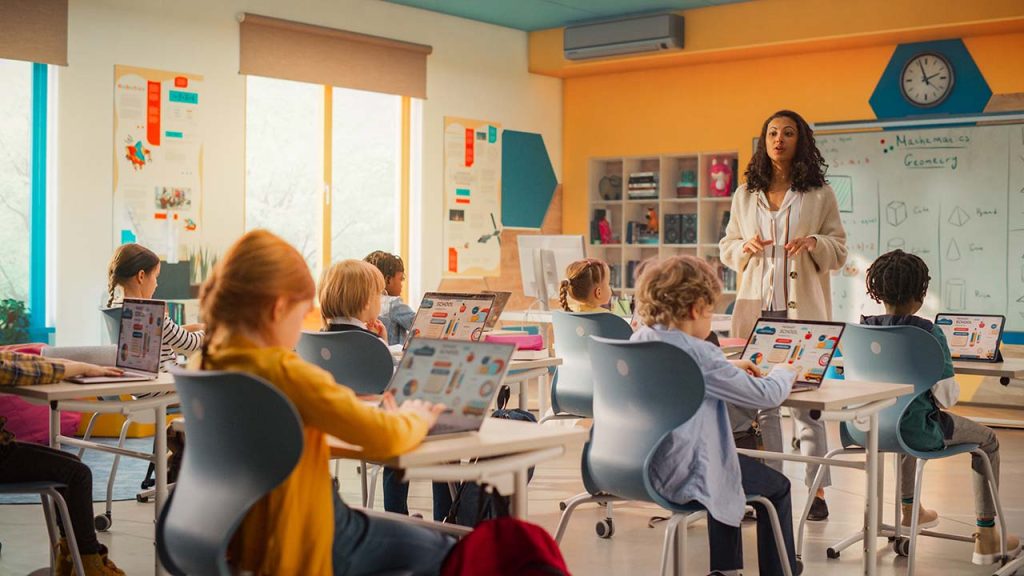
Finding the Source of PCB Contamination in Schools Just Got Easier
For years, researchers have known that the toxic chemicals known as PCBs are present in thousands of school buildings nationwide, potentially jeopardizing the health of the children who learn in them and the adults who work there. But the persistent question has been: Where exactly?
Districts confused and anxious about the prospect of a PCB discovery upending their operations or forcing them to shut down their buildings may find some relief on the horizon.
In a new peer-reviewed paper published Friday in the American Chemical Society’s Environmental Science & Technology journal, researchers at the University of Iowa’s Superfund Research Program say they have for the first time successfully executed a method to isolate PCB contamination to specific materials in a school classroom.
The findings come from the researchers’ analysis of a single elementary school building in southeast Vermont. The findings don’t comprehensively address the extent of PCB use in school construction materials. But they point to a concrete step districts can take to understand the extent of PCB contamination that could put far less strain on their budgets than tearing apart an entire building.
“A year ago, I thought it was possible that all schools built before 1980 had high levels [of PCBs],” said Keri Hornbuckle, the University of Iowa professor of civil engineering who led the study. “Now we know that it is indeed individual materials and individual school rooms that are relevant.”
School districts could save money if they apply these findings
The findings from Hornbuckle and her colleagues could be a major boon for the thousands of U.S. school districts with buildings that have stood since before 1979, when the U.S. Environmental Protection Agency banned the manufacture of polychlorinated biphenyls, or PCBs.
This class of chemicals emerged decades earlier as a powerful tool to help building materials stick more closely together and last longer. But prolonged exposure to PCBs can lead to a wide array of negative health impacts, including cancer, as well as shorter-term impacts including difficulty breathing and shortened attention spans.
Researchers estimate thousands of school buildings nationwide likely contain harmful levels of PCBs. Several school districts in recent years—including in Connecticut, California, Vermont, and Washington state—have torn down or shuttered buildings where high PCB levels were detected.
The fallout from PCB contamination has also prompted a rising wave of litigation by states, school districts, and individuals against the companies that manufactured these chemicals while allegedly knowing they were dangerous. In recent weeks, for instance, a handful of parents in Pittsfield, Mass., filed lawsuits against PCB manufacturers alleging that contamination in schools and other places sickened them and their children. PCB manufacturers have challenged most lawsuits and argued they’re not culpable for the chemicals’ harmful effects.
Exactly which school buildings contain the most dangerous PCBs, and where those PCBs are most heavily concentrated, have been mysteries. However, the method Hornbuckle and her team employed to locate the highest concentration of PCBs could start to solve them.
The new findings emerged from a research study in Vermont, where the state since 2021 has led a legally mandated PCB testing effort in all pre-1980 school buildings. Hornbuckle and her colleagues gathered 30 days of air samples to detect general PCB contamination, and they also deployed emissions samplers that absorbed PCBs coming from a variety of surfaces, including vinyl tiles, carpets, painted bricks, and painted drywall. They did their work in three rooms in the unnamed school that dates to 1958, during the prime of PCB use in building construction.
The air samples confirmed PCBs were present. But the samples of individual materials were more revealing.
Of the building components the researchers examined, glass block windows had a concentration of PCBs that far exceeded PCB concentrations in other materials like caulk and paint, Hornbuckle said.
In the glass block windows, the PCBs were concentrated not on the edge of the windows or the mortar attaching it to the wall, but in the center of the glass blocks themselves.
This finding surprised researchers, given that PCBs are often used as sealants or flame retardants. “Why a glass block window would be a risk to catch on fire is beyond me,” Hornbuckle said.
She knows from previous research that PCBs tend to leach into the air more quickly when they’re exposed to hot temperatures. So it makes sense that a window with PCBs exposed to direct sunlight might pose a particular risk for contamination—especially during the day, when people are most likely to occupy the room.
Hornbuckle isn’t calling for schools en masse to tear down their glass block windows. In fact, she was struck walking into the classroom by how attractive they looked. “I would want my kids to go to a school that had a room as beautiful as that,” she said. Unless, of course, it contained high levels of PCBs.
The message from Hornbuckle and her team, rather, is that directly measuring PCB emissions from individual building components holds promise as schools try to get to the bottom of their PCB contamination problems.
Pinpointing PCB sources can be tricky
The new research adds supporting evidence to longstanding assumptions about how PCBs travel in schools, said Kevin Coghlan, president and chief operating officer of Environmental Health & Engineering, a company that conducts PCB testing in schools across the country.
PCBs contained within one building material don’t just seep into the air, but into other building materials as well. Even if the windows weren’t constructed with PCBs, they could eventually accumulate enough PCBs to require remediation.
“If you’re having difficulty in driving down those airborne levels of PCBs, it may be because these other unidentified sources just haven’t been characterized,” Coghlan said.
Federal regulations require that solid objects with PCBs detected at levels over 50 parts per million be considered toxic waste and discarded immediately and safely. But there’s no federal regulation that requires action when the air contains high levels of PCBs.
Burlington High School in Burlington, Vt., shut down in 2020 in part because it was impossible to determine precisely where in the building high levels of PCB contamination in the air were coming from: Caulk? Paint? Light fixtures? All of the above? The building has since been torn down, and the district is spending more than $200 million to construct a replacement while students attend school in a former Macy’s department store building.
Burlington’s experience led Vermont to require all schools to be tested for PCBs. But in other states, many school districts have been reluctant to test buildings for PCBs because the cost of remediating any uncovered issues is too steep to fathom.
That’s why understanding the sources of PCB contamination is so important, Hornbuckle said. If air samples in a particular room come back highly positive, the next step should be sampling individual components and isolating those. Removing those windows might be costly, but it would be far less disruptive than tearing down a whole school building.
Coghlan said the methods Hornbuckle’s team used are promising and could be fairly easy for schools or the contractors they hired to deploy.
“It provides a very good investigation tool to better understand the contribution of various sources of PCBs in the school environment,” he said.
It’s too early to tell whether glass block windows will be the primary source in every classroom where PCBs are prevalent. But the new research affirms that testing individual materials is worth the effort.
“My deepest worry is that wealthy communities that can afford to make the measurement and afford to replace their schools [will do so], and that will become the strategy for dealing with PCBs in schools,” Hornbuckle said. “That is not going to work for the vast majority of our nation’s schools that run on shoestring budgets.”
Researchers want to understand how much PCB remediation is needed nationwide
The latest PCB findings may help school leaders avert the most catastrophic outcomes of toxic chemical findings. They’ll also help researchers more precisely estimate the nationwide cost of remediating PCBs in schools, Hornbuckle said.
Many schools, particularly in low-wealth areas, won’t be able to afford to do what they’d need to if they came upon harmful levels of PCBs, Hornbuckle said.
But knowing which building materials might have to be removed is a first step. It lays the groundwork for a nationwide assessment of the overall cost of eliminating PCBs from schools, she said.
“You can’t replace all the schools in the United States that have high PCB levels,” she said. “We also cannot leave behind the kids that are in the schools that most need repair.”
Dig Deeper With Our Longreads
Newsletter Sign up to get our best longform features, investigations, and thought-provoking essays, in your inbox every Sunday.
The MEN was founded by John Huber in the fall of 2020. It was founded to provide a platform for expert opinion and commentary on current issues that directly or indirectly affect education. All opinions are valued and accepted providing they are expressed in a professional manner. The Maryland Education Network consists of Blogs, Videos, and other interaction among the K-12 community.







